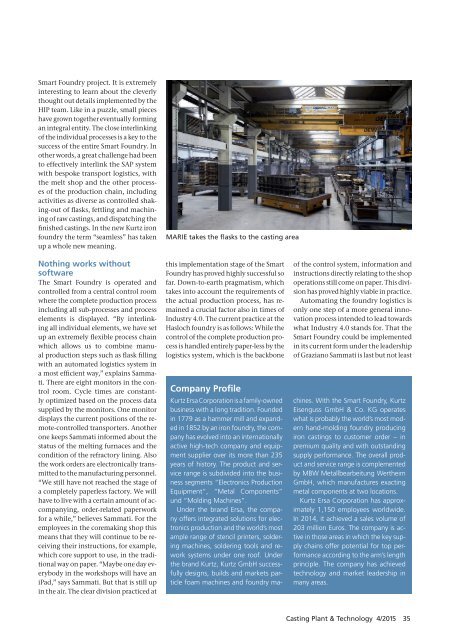CPT International 04/2015
The leading technical journal for the global foundry industry – Das führende Fachmagazin für die weltweite Gießerei-Industrie
The leading technical journal for the
global foundry industry – Das führende Fachmagazin für die
weltweite Gießerei-Industrie
You also want an ePaper? Increase the reach of your titles
YUMPU automatically turns print PDFs into web optimized ePapers that Google loves.
Smart Foundry project. It is extremely<br />
interesting to learn about the cleverly<br />
thought out details implemented by the<br />
HIP team. Like in a puzzle, small pieces<br />
have grown together eventually forming<br />
an integral entity. The close interlinking<br />
of the individual processes is a key to the<br />
success of the entire Smart Foundry. In<br />
other words, a great challenge had been<br />
to effectively interlink the SAP system<br />
with bespoke transport logistics, with<br />
the melt shop and the other processes<br />
of the production chain, including<br />
activities as diverse as controlled shaking-out<br />
of flasks, fettling and machining<br />
of raw castings, and dispatching the<br />
finished castings. In the new Kurtz iron<br />
foundry the term “seamless” has taken<br />
up a whole new meaning.<br />
MARIE takes the flasks to the casting area<br />
Nothing works without<br />
software<br />
The Smart Foundry is operated and<br />
controlled from a central control room<br />
where the complete production process<br />
including all sub-processes and process<br />
elements is displayed. “By interlinking<br />
all individual elements, we have set<br />
up an extremely flexible process chain<br />
which allows us to combine manual<br />
production steps such as flask filling<br />
with an automated logistics system in<br />
a most efficient way,” explains Sammati.<br />
There are eight monitors in the control<br />
room. Cycle times are constantly<br />
optimized based on the process data<br />
supplied by the monitors. One monitor<br />
displays the current positions of the remote-controlled<br />
transporters. Another<br />
one keeps Sammati informed about the<br />
status of the melting furnaces and the<br />
condition of the refractory lining. Also<br />
the work orders are electronically transmitted<br />
to the manufacturing personnel.<br />
“We still have not reached the stage of<br />
a completely paperless factory. We will<br />
have to live with a certain amount of accompanying,<br />
order-related paperwork<br />
for a while,” believes Sammati. For the<br />
employees in the coremaking shop this<br />
means that they will continue to be receiving<br />
their instructions, for example,<br />
which core support to use, in the traditional<br />
way on paper. “Maybe one day everybody<br />
in the workshops will have an<br />
iPad,” says Sammati. But that is still up<br />
in the air. The clear division practiced at<br />
this implementation stage of the Smart<br />
Foundry has proved highly successful so<br />
far. Down-to-earth pragmatism, which<br />
takes into account the requirements of<br />
the actual production process, has remained<br />
a crucial factor also in times of<br />
Industry 4.0. The current practice at the<br />
Hasloch foundry is as follows: While the<br />
control of the complete production process<br />
is handled entirely paper-less by the<br />
logistics system, which is the backbone<br />
Company Profile<br />
of the control system, information and<br />
instructions directly relating to the shop<br />
operations still come on paper. This division<br />
has proved highly viable in practice.<br />
Automating the foundry logistics is<br />
only one step of a more general innovation<br />
process intended to lead towards<br />
what Industry 4.0 stands for. That the<br />
Smart Foundry could be implemented<br />
in its current form under the leadership<br />
of Graziano Sammati is last but not least<br />
Kurtz Ersa Corporation is a family-owned<br />
business with a long tradition. Founded<br />
in 1779 as a hammer mill and expanded<br />
in 1852 by an iron foundry, the company<br />
has evolved into an internationally<br />
active high-tech company and equipment<br />
supplier over its more than 235<br />
years of history. The product and service<br />
range is subdivided into the business<br />
segments “Electronics Production<br />
Equipment”, “Metal Components”<br />
und “Molding Machines”.<br />
Under the brand Ersa, the company<br />
offers integrated solutions for electronics<br />
production and the world’s most<br />
ample range of stencil printers, soldering<br />
machines, soldering tools and rework<br />
systems under one roof. Under<br />
the brand Kurtz, Kurtz GmbH successfully<br />
designs, builds and markets particle<br />
foam machines and foundry machines.<br />
With the Smart Foundry, Kurtz<br />
Eisenguss GmbH & Co. KG operates<br />
what is probably the world’s most modern<br />
hand-molding foundry producing<br />
iron castings to customer order – in<br />
premium quality and with outstanding<br />
supply performance. The overall product<br />
and service range is complemented<br />
by MBW Metallbearbeitung Wertheim<br />
GmbH, which manufactures exacting<br />
metal components at two locations.<br />
Kurtz Ersa Corporation has approximately<br />
1,150 employees worldwide.<br />
In 2014, it achieved a sales volume of<br />
203 million Euros. The company is active<br />
in those areas in which the key supply<br />
chains offer potential for top performance<br />
according to the arm’s length<br />
principle. The company has achieved<br />
technology and market leadership in<br />
many areas.<br />
Casting Plant & Technology 4/<strong>2015</strong> 35


















